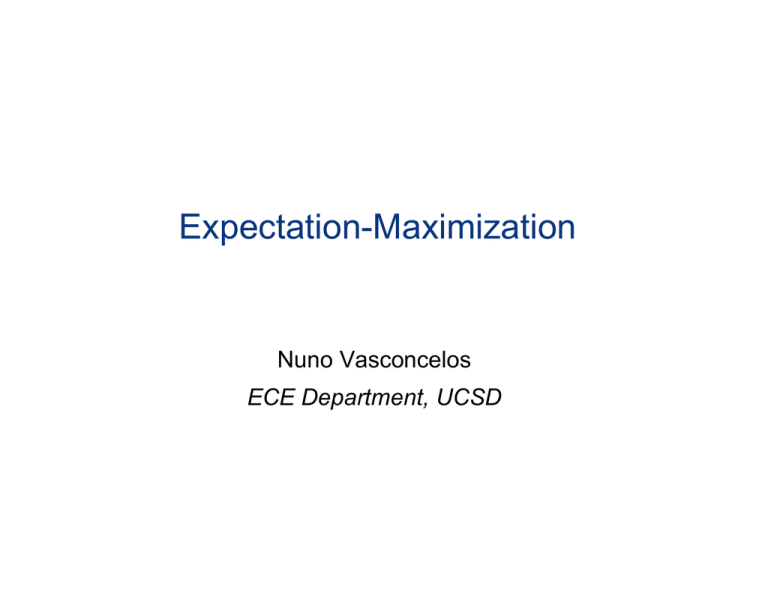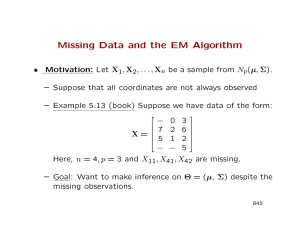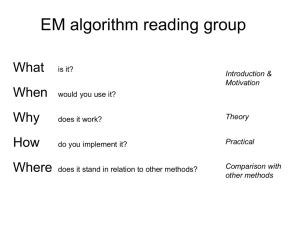Expectation-Maximization
advertisement

Expectation-Maximization
Nuno Vasconcelos
ECE Department,
p
, UCSD
Recall
last class, we will have “Cheetah Day”
what:
• 4 teams, average of 6 people
• each team will write a report
p on the 4
cheetah problems
• each team will give a presentation on one
of the problems
p
I am waiting to hear on the teams
2
Plan for today
we have been talking about mixture models
last time we introduced the basics of EM
today we study the application of EM for ML estimation of
mixture parameters
p
nextt class:
l
• proof that EM maximizes likelihood of incomplete data
3
mixture model
two types of random variables
• Z – hidden state variable
PZ(z)
zi
• X – observed variable
observations sampled
p
with a
two-step procedure
• a state (class) is sampled from the
distribution of the hidden variable
PZ(z) → zi
PX|Z(x|0) PX|Z(x|1)
…
PX|Z(x|K)
xi
• an observation is drawn from the class conditional density for
the selected state
PX|Z(x|zi) → xi
4
mixture model
the sample consists of pairs (xi,zi)
D = {(x1,zz1),
) …, (xn,zzn)}
but we never get to see the zi
the pdf of the observed data is
# of mixture components
component “weight”
cth “mixture component”
5
The basics of EM
as usual, we start from an iid sample D = {x1,…,xN}
goal is to find parameters Ψ* that maximize likelihood with
respect to D
the set
Dc = {(x1,z1), …, (xN,zN)}
is called the complete data
the set
D = {{x1, …,, xN}
is called the incomplete data
6
Learning with incomplete data (EM)
the basic idea is quite simple
1 start with an initial parameter estimate Ψ((0))
1.
2. E-step: given current parameters Ψ(i) and observations in D,
“guess” what the values of the zi are
3. M-step: with the new zi, we have a complete data problem,
solve this problem for the parameters, i.e. compute Ψ(i+1)
4. go to 2.
this can be summarized as
p
E-step
estimate
parameters
M-step
fill in class
assignments
zi
7
Classification-maximization
C-step:
•
given estimates Ψ ((i)) = {Ψ ((i))1, …, Ψ ((i))C }
•
determine zi by the BDR
•
split the training set according to the labels zi
D1 = {xi|zi=1},
D2 = {xi|zi=2}, … , DC = {xi|zi=C}
M-step:
•
as before,
before determine the parameters of each class
independently
8
For Gaussian mixtures
C-step:
•
•
split the training set according to the labels zi
D1 = {xi|zi=1},
D2 = {xi|zi=2}, … , DC = {xi|zi=C}
M-step:
•
9
K-means
when covariances are identity and priors uniform
C step:
C-step:
•
•
split
p the training
g set according
g to the labels zi
D1 = {xi|zi=1},
D2 = {xi|zi=2}, … , DC = {xi|zi=C}
M-step:
•
this is the K-means algorithm,
algorithm aka generalized Loyd
algorithm, aka LBG algorithm in the vector quantization
literature:
•
“assign points to the closest mean; recompute the means”
10
The Q function
is defined as
and is a bit tricky:
• it is the expected value of likelihood with respect to complete data
(joint X and Z)
• g
given that we observed incomplete
p
data ((X=D)
• note that the likelihood is a function of Ψ (the parameters that we
want to determine)
• b
butt to
t compute
t the
th expected
t d value
l we need
d to
t use the
th parameter
t
values from the previous iteration (because we need a
distribution for Z|X)
the EM algorithm is, therefore, as follows
11
Expectation-maximization
E-step:
•
given estimates Ψ ((n)) = {Ψ ((n))1, …, Ψ ((n))C }
•
compute expected log-likelihood of complete data
M-step:
•
find parameter set that maximizes this expected log-likelihood
let’s make this more concrete by looking at the mixture
case
12
Expectation-maximization
to derive an EM algorithm you need to do the following
1 write down the likelihood of the COMPLETE data
1.
2. E-step: write down the Q function, i.e. its expectation given the
observed data
3. M-step: solve the maximization, deriving a closed-form solution if
there is one
13
EM for mixtures (step 1)
the first thing we always do in a EM problem is
•
compute the likelihood of the COMPLETE data
very neat trick to use when z is discrete (classes)
•
instead of using
g z in {{1,, 2,, ...,, C}}
•
use a binary vector of size equal to the # of classes
•
where z = j in the z in {1, 2, ..., C} notation, now becomes
14
EM for mixtures (step 1)
we can now write the complete data likelihood as
for example, if z = k in the z in {1, 2, ..., C} notation,
the advantage is that
becomes LINEAR in the components zj !!!
15
The assignment vector trick
this is similar to something that we used already
Bernoulli random variable
⎧ p
PZ ( z ) = ⎨
⎩1 − p
z =1
z=0
can be written as
1− z
PZ ( z ) = p (1 − p )
z
⎧ ⎡0⎤ ⎡1⎤ ⎫
or, using z ∈ ⎨ ⎢ ⎥, ⎢ ⎥ ⎬ instead of z ∈ {0,1}, as
⎩ ⎣1⎦ ⎣0⎦ ⎭
PZ ( z ) = p z1 (1 − p ) z2
16
EM for mixtures (step 1)
for the complete iid dataset Dc = {(x1,z1), …, (xN,zN)}
and the complete data log-likelihood is
this does not depend on z and simply becomes a
constant for the expectation that we have to compute in
p
the E-step
17
Expectation-maximization
to derive an EM algorithm you need to do the following
1 write down the likelihood of the COMPLETE data
1.
2. E-step: write down the Q function, i.e. its expectation given the
observed data
3. M-step: solve the maximization, deriving a closed-form solution if
there is one
important
p
E-step
p advice:
•
do not compute terms that you do not need
•
at the end of the day we only care about the parameters
•
terms of Q that do not depend on the parameters are useless,
e.g. in
Q = f(z,Ψ) + log(sin z)
th expected
the
t d value
l off log(sin
l ( i z)) appears to
t be
b difficult
diffi lt and
d is
i
completely unnecessary, since it is dropped in the M-step
18
EM for mixtures (step 2)
once we have the complete data likelihood
i.e. to compute the Q function we only need to compute
note that this expectation can only be computed
because we use Ψ(n)
note that the Q function will be a function of both Ψ and
Ψ(n)
19
EM for mixtures (step 2)
since zij is binary and only depends on xi
the E-step reduces to computing the posterior
probability of each point under each class!
defining
the Q function is
20
Expectation-maximization
to derive an EM algorithm you need to do the following
1 write down the likelihood of the COMPLETE data
1.
2. E-step: write down the Q function, i.e. its expectation given the
observed data
3. M-step: solve the maximization, deriving a closed-form solution if
there is one
21
EM vs CM
let’s compare this with the CM algorithm
•
the C-step
assigns each point to the class of largest posterior
•
the E-step
assigns the point to all classes with weight given by the posterior
for this, EM is said to make “soft-assignments”
soft assignments
•
it does not commit to any of the classes (unless the posterior is
one for that class), i.e. it is less greedy
•
no longer partition space into rigid cells, but now the boundaries
are soft
22
EM vs CM
what about the M-steps?
•
for CM
•
for EM
these are the same if we threshold the hij to make, for
each i, maxj hij = 1 and all other hij = 0
M t
M-steps
the
th same up to
t the
th difference
diff
off assignments
i
t
23
EM for Gaussian mixtures
in summary:
•
CM = EM + hard assignments
•
CM special case, cannot be better
let’s look at the special case of Gaussian mixtures
E-step:
24
M-step for Gaussian mixtures
M-step:
important note:
•
in the M-step,
p, the optimization
p
must be subject
j
to whatever
constraint may hold
•
in particular, we always have the constraint
•
as usual we introduce a Lagrangian
25
M-step for Gaussian mixtures
Lagrangian
setting derivatives to zero
26
M-step for Gaussian mixtures
leads to the update equations
comparing
p
g to those of CM
they
ey a
are
e the
e sa
same
e up to
o hard
a d vss so
soft ass
assignments.
g e s
27
Expectation-maximization
note that the procedure is the same for all mixtures
1 write down the likelihood of the COMPLETE data
1.
2. E-step: write down the Q function, i.e. its expectation given the
observed data
3. M-step: solve the maximization, deriving a closed-form solution if
there is one
28
Expectation-maximization
E.g. for a mixture of exponential distributions
C
PX ( x ) = ∑ π i λi e −λi x
i =1
1 E-step: write down the Q function,
1.
function i.e.
i e its expectation given the
observed data
hij = PZ |X ( j | xi ) =
π jλ je
− λ j xi
C
−λ x
π
λ
e
∑ cc
c i
c =1
2. M-step: solve the maximization, deriving a closed-form solution if
there is one
29
M-step for exponential mixtures
M-step:
[
Ψ ( n +1) = arg max ∑ hij log
l π jλ je
Ψ
− λ j xi
]
ij
= arg min ∑ hij (λ j xi − log[π j λ j ])
Ψ
ij
the Lagragian is
⎛
⎞
L = ∑ hij (λ j xi − log
l λ j − log
l π j ) + κ ⎜⎜ ∑ π j − 1⎟
ij
⎠
⎝ j
30
M-step for exponential mixtures
⎛
⎞
L = ∑ hij (λ j xi − log λ j − log π j ) + κ ⎜⎜ ∑ π j − 1⎟⎟
ijj
⎝ j
⎠
and has minimum at
⎛
1
∂L
= ∑ hik ⎜⎜ xi −
λk
∂λk
i
⎝
⎞
⎟⎟ = 0
⎠
hik
∂L
= −∑ + κ = 0
∂π k
i πk
∂L
= ∑π j − 1 = 0
∂κ
j
1
λk
∑h x
=
∑h
ik i
i
ik
i
κ = ∑ hik
ij
πk
∑h
=
∑h
ik
i
ik
ij
31
EM algorithm
note, however, that EM is much more general than this
recipe
p for mixtures
it can be applied for any problem where we have
observed and hidden random variables
here is a very simple example
•
X observer Gaussian variable, X~ N(µ,1),
•
Z hidden exponential variable
•
It is known that Z is independent of X
•
sample D = {x1, …, xn} of iid observations from X
note that the assumption of independence does not
really make sense (why?)
how does this affect EM?
32
Example
toy model: X iid, Z iid, Xi ~ N(µ,1), Zi ~ λe-λz,
X independent of Z
33
Example
this makes sense:
• since hidden variables Z are independent of observed X
• ML estimate of µ is always the same: the sample mean, no
dependence on zi
• ML estimate of λ is always the initial estimate λ(0): since the
observations are independent of the zi we have no information on
what λ should be
be, other than initial guess
guess.
note that model does not make sense, not EM solution
34
35


